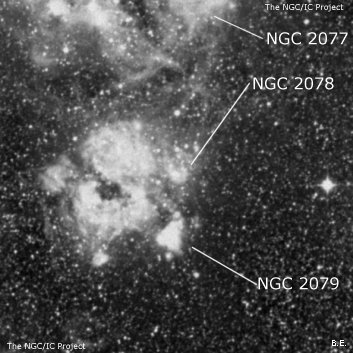
R148 forms a 6" pair - not logged in either of the two observations above - with the optical counterpart (V ≈ 14.8) of LMC X-1, a 10 solar-mass black hole and variable X-ray source. Nearby is the impressive LMC-N160 complex with NGC's 2077 and 2080, another very bright patch of nebulosity 6' N, and NGC's 2085 and 2086, a smaller bright pair, a similar distance to the NE. This complex, along with LMC-N159, is within the O-association LH 105.
John Herschel discovered NGC 2078 = h2948 on 23 Dec 1834 and recorded "the north preceding of the four principal nuclei of the nebula of Plate III, figure 4." Herschel's sketch shows a complex object with 7 condensations or nuclei, involved in nebulosity. The four NGC objects in this grouping are NGC 2078, 2079, 2083 and NGC 2084. Glen Cozens and Wolfgang Steinicke assign Dunlop's #149 (discovered in 1826) to NGC 2078. Dunlop recorded "a faint round nebula, about 1' diameter" and his position is 6' due east of this emission nebula. But unless there is additional information available, I don't see how a specific object in this complex can be assigned to D 149.
600/800mm - 24" (4/9/08 - Magellan Observatory, Australia): this is the northwest component of an impressive 4' emission nebula filled with bright knots (LMC-N159), several of which form a curving "S" shape. At 200x and UHC filter it appeared as a fairly bright, moderately large glow surrounding a mag 12 star (B5 supergiant R148) and two fainter stars. This knot is elongated ~E-W, ~1.2'x0.8' and is encased in a fainter outer halo that extends perhaps 1.5', mostly to the north. NGC 2079, an extremely bright isolated patch, lies 1.7' S, NGC 2083 is a similar distance to the east and NGC 2084 is 2.5' SE.
Notes by Steve Gottlieb